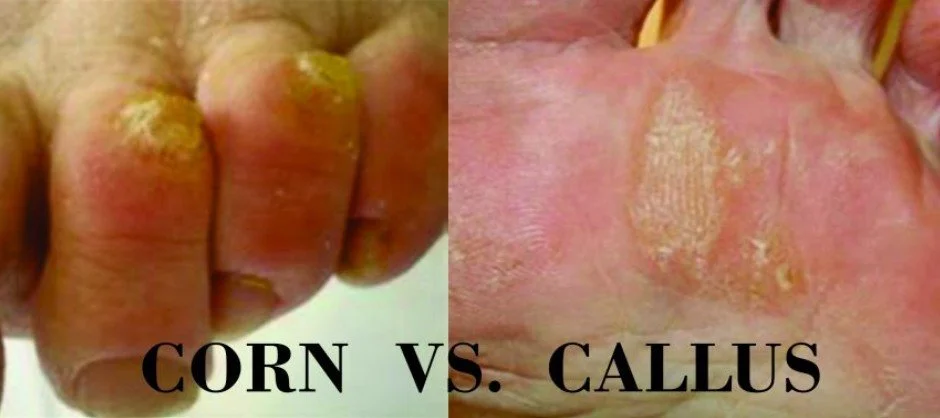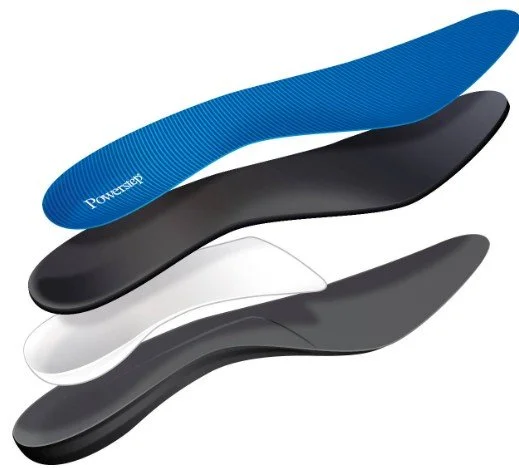Corns and Calluses: What They Really Mean and How to Treat Them
If you feel like you are walking on a tiny pebble that never leaves, you may have a corn or a callus. These thicker skin areas are your body’s protective response to repeated rubbing or pressure. They are common, often annoying, and very treatable without toughing it out.¹
What Are Corns and Calluses
Corns and calluses form when skin experiences repeated rubbing or pressure. Your body responds by creating extra keratin to protect the area underneath.¹
Corns are smaller and more focused. They usually show up on or between toes and often have a firm center.¹
Calluses are broader and flatter. They typically sit under the ball of the foot or the heel where pressure is highest.¹
The difference matters because the best treatment depends on where the pressure starts and how your foot loads during walking.²
It’s Physics, Not “Tough Feet”
Each step can send two to three times your body weight through your feet. When that force is not balanced, skin thickens to defend the deeper tissues.²
Why They Form
Most corns and calluses come from mechanical overload — a specific spot is taking more pressure than it should.²
Common causes include:
Shoes that are too tight, too loose, or too narrow²
Toe deformities such as hammertoes or bunions that create rubbing²
High arches or flat feet that shift weight unevenly²
Hard floors with barefoot time that adds friction²
Age-related fat pad thinning that reduces natural cushioning²
Diabetes or neuropathy that alter pressure awareness and healing¹
🦶 Related Reading: Plantar Fasciitis Treatment Guide
Corn vs Callus: Quick Comparison
If you can point to one tiny sharp spot that feels like a pebble, it is likely a corn. If it is a thicker patch that aches across a wider area, it is likely a callus.¹
When to See a Podiatrist
Corns and calluses may seem harmless, but chronic pressure can lead to cracks, blisters, and even ulcers — especially in people with diabetes or circulation problems.¹
See a podiatrist if:
The area is painful, bleeding, or cracking
You see redness or drainage
You have diabetes or neuropathy
The spot keeps coming back after home care
It interferes with walking, work, or exercise
In clinic, we can safely remove the thickened skin and address the pressure source so relief lasts.¹
👣 Also Helpful: Your Foot and Ankle Anatomy Guide
Home Treatment and Prevention
The key to lasting relief is removing the source of pressure, not just the dead skin.¹ ²
Step 1: Fix the Footwear
Choose a wide toe box and a soft upper to reduce rubbing
Make sure there is enough depth if you add insoles or orthotics
Avoid shoes that pinch or slide while walking
Clinically Trusted Picks:
Step 2: Gently Thin the Skin
Soak feet in warm water for 10 to 15 minutes
Use a pumice stone or foot file 1–2 times per week
Apply a urea-based cream nightly (20–40%)
Recommended creams:
⚠️ Important: Avoid medicated corn pads with salicylic acid unless prescribed — they can burn healthy skin, especially in people with diabetes.¹
Step 3: Offload Pressure
Use silicone toe sleeves, foam pads, or orthotic inserts to spread pressure²
Use soft gel separators for corns between toes²
Custom or OTC orthotics can help if alignment keeps pressure concentrated²
Step 4: Keep Skin Healthy
Moisturize daily
Wear moisture-wicking socks
Do not peel or pick at thickened skin
Trim toenails straight to limit rubbing in shoes
💡 Quick Tip: If a corn keeps returning, your body is telling you that something about your gait or shoe fit is still off. Treat the cause for long-term relief.²
What Happens in the Office
Debridement: Thickened skin is safely removed with sterile tools — immediate relief.¹
Assessment: We evaluate shoe fit, foot shape, and gait to find the true source of pressure.²
Correction: Pads, footwear changes, orthotics, or occasionally a small minimally invasive procedure if a bone prominence keeps causing pressure.² ³
Most patients walk out more comfortable within minutes.¹
Pediatric Note
Corns are uncommon in children. Repeated calluses can signal early gait issues or toe shape changes that should be addressed before they cause discomfort or activity limitations.³
👶 Parents Start Here: Pediatric Flatfoot: What Parents Need to Know
Common Myths and the Real Truth
When Surgery Is Considered
Surgery is rare. It may be needed when a bone spur or hammertoe keeps pressing, when months of conservative care have failed, or when pain limits daily life.
Most procedures are minimally invasive with fast recovery.³
Prevention That Works
Rotate shoes daily so materials rebound
Keep skin moisturized
Check your feet often, especially if diabetic
Use cushioning for workouts on hard floors
Address deformities or gait issues early
The Bottom Line
Healthy skin follows healthy pressure. You should not feel a hot spot every step you take.
If you do, we can fix both the skin and the source.¹ ²
🛠️ Feet Made Simple: Products I Recommend for Corns & Calluses
These are evidence-based, clinic-tested products that help reduce pressure, soften thickened skin, and keep your feet healthy. I use or recommend each of these regularly in practice.
👟 Shoes & Footwear
Brooks Ghost Max 3 – Excellent shock absorption and rocker sole for reduced forefoot stress
Hoka Bondi 9 – Plush cushioning for pressure relief and comfort on long days
Topo Ultraventure 4 – Wide toe box and stable base to prevent toe rubbing
🧴 Skin Care & Creams
Urea 40% Cream – Deep-penetrating urea formula for thick or dry callused areas
🦶 Pressure Relief & Protection
Silicone Toe Sleeves – Reduce friction and protect toes from corns
Orthotic Inserts – Distribute weight evenly and prevent recurrence of pressure spots
🪶 Exfoliation Tools
Pumice Stone – Use after soaking to safely smooth thick skin
References
¹ Naylor J, Singh D. Corns and Callosities: Current Understanding and Treatment. Journal of Foot and Ankle Surgery. 2023.
² Langer P. Biomechanical Contributors to Recurrent Plantar Callosities and Their Management. Journal of the American Podiatric Medical Association. 2022.
³ Hsi R, et al. Mechanical Overload Syndromes of the Foot and Modern Care Pathways. Foot and Ankle International. 2021.



